Retro Corner: Dynamite Cop
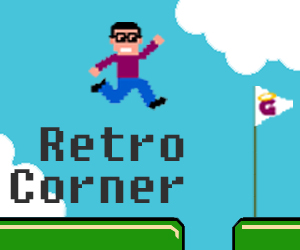 Game: Dynamite Cop (1999)
Game: Dynamite Cop (1999)
Developer: AM1
Publisher: SEGA
Originally Released on: Arcade, SEGA Dreamcast
Currently Available on: Second-hand: eBay, etc.
When Die Hard 4.0 was released in cinemas back in 2007, most movie fans would have been forgiven for thinking that would be the end of the saga for Bruce Willis and his John McClane character. What more could he do? This latest movie had passed the torch in a way from the bombastic physical action films of old to a more modern, technological thriller – complete with a new young protagonist. However, just as his enemies have learned in all of the previous films, you just can’t keep John McClane down, and Bruce Willis is returning to the role this February in the fifth film in the series, A Good Day to Die Hard.
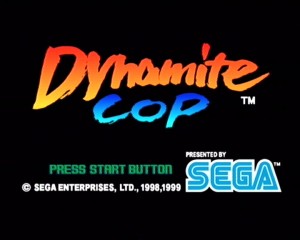 Now, there have been a few licensed games based on the Die Hard saga, and as you would expect, there have certainly been some mixed results, but perhaps the most interesting Die Hard-related games are the two Dynamite Deka titles from SEGA. The first game was released as Dynamite Deka in the Arcades in Japan in 1996, before getting a SEGA Saturn home console version. It was a Final Fight style arcade beat-em-up, that featured several police officers infiltrating a skyscraper in order to save the daughter of the President from terrorists.
Now, there have been a few licensed games based on the Die Hard saga, and as you would expect, there have certainly been some mixed results, but perhaps the most interesting Die Hard-related games are the two Dynamite Deka titles from SEGA. The first game was released as Dynamite Deka in the Arcades in Japan in 1996, before getting a SEGA Saturn home console version. It was a Final Fight style arcade beat-em-up, that featured several police officers infiltrating a skyscraper in order to save the daughter of the President from terrorists.
The strange issue arises when the game was released in the West, where SEGA wanted to attach a movie license to the title. Being that it took place in a skyscraper with terrorists, Die Hard made a perfect fit, and the game was tweaked a little here and there to change the protagonist to be John McClane, and we were left with Die Hard Arcade. Obviously not a licensed game, the idea bore many similarities to the plot of the first Die Hard film, and gamers would fight their way through different floors of the building, using weapons and other found objects to beat up enemies or replenish health.
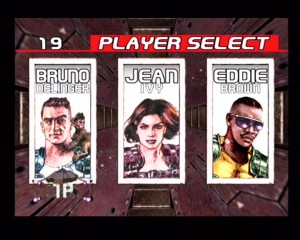 When the Dreamcast launched, an inevitable sequel was planned, but SEGA had difficulty in securing the Die Hard license for this title. It was designed as very much the same sort of game, this time set on a cruise liner, gamers again had to rescue the clearly kidnap-prone President’s daughter. Although the premise here was something closer to Speed 2 than a Die Hard movie, the main character was clearly modeled on Bruce Willis to an extent, and SEGA intended to carry on the franchise, but eventually they failed in their attempts to seal the license deal, and therefore had to re-brand the title. John McClane was re-named Bruno Delinger, and the game was released as Dynamite Deka 2 in Japan, and Dynamite Cop internationally.
When the Dreamcast launched, an inevitable sequel was planned, but SEGA had difficulty in securing the Die Hard license for this title. It was designed as very much the same sort of game, this time set on a cruise liner, gamers again had to rescue the clearly kidnap-prone President’s daughter. Although the premise here was something closer to Speed 2 than a Die Hard movie, the main character was clearly modeled on Bruce Willis to an extent, and SEGA intended to carry on the franchise, but eventually they failed in their attempts to seal the license deal, and therefore had to re-brand the title. John McClane was re-named Bruno Delinger, and the game was released as Dynamite Deka 2 in Japan, and Dynamite Cop internationally.
Despite those name changes, the game was more or less the same as what we came to expect after the first title. A 3D brawler, for one or two players, the game featured fighting against waves of increasingly strange and more difficult bad guys, interspersed with boss battles and quick-time events. In the title you can choose one of three characters, those being; Captain Bruno Delinger, Navy Seal Jean Ivy and ex-NFL great turned Navy Seal, Corporal Eddie Brown (who was not only black as his name might suggest, but also bore more than a slight resemblance to Eddie Murphy). Who you choose has little impact on gameplay, as all of the fighters have the same moveset aside from a couple of unique melee attacks. The movesets are quite deep with a wide array of throws and power moves, but you will find yourself just hammering buttons to perform the basic attacks more often than not.
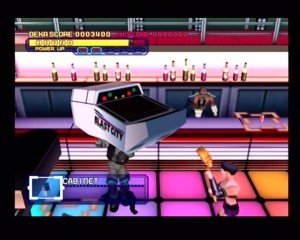 Add to that the environmental and weapon-based attacks, of which there are many, which range from the mundane such as Uzis, to the strange ones like shaking a pepper mill at your enemies, to the downright absurd, which includes a mini nuclear weapon that sends everyone on-screen flying into the stratosphere. These will all be dropped by the player when used too much or when you change scenes – aside from the handgun which can be carried over to new areas. Anything else you see can be used as a weapon; more or less. Run out of guns? Smash a chair over the head of your enemy. These are all pretty entertaining and the lack of realism helps make things more enjoyable. The game would certainly be a lot more dull without these over-the-top attacks.
Add to that the environmental and weapon-based attacks, of which there are many, which range from the mundane such as Uzis, to the strange ones like shaking a pepper mill at your enemies, to the downright absurd, which includes a mini nuclear weapon that sends everyone on-screen flying into the stratosphere. These will all be dropped by the player when used too much or when you change scenes – aside from the handgun which can be carried over to new areas. Anything else you see can be used as a weapon; more or less. Run out of guns? Smash a chair over the head of your enemy. These are all pretty entertaining and the lack of realism helps make things more enjoyable. The game would certainly be a lot more dull without these over-the-top attacks.
This is largely because the game is very repetitive. Each scene you enter will provide the same basic challenge; defeat a wave of minions, fight a few heavy enemies, then proceed. Rinse and repeat until end. Boss battles can be pretty funny – such as the incredibly random giant octopus that you have to destroy at one point – but all of them are fought in more or less the same manner. There is nothing to differentiate fighting a regular enemy from fighting a boss, aside from the size of their health bar. It must be said that aside from the waves of faceless goons, there are many very odd enemies you have to fight, such as men in turtle or shark suits; none of which is ever explained. Just one of those classic SEGA eccentricities I suppose!
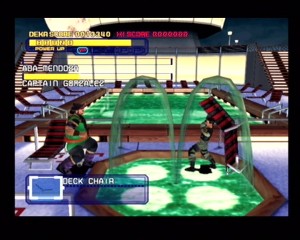 Add the fact that the game is very short to the repetitive nature of the gameplay, and there isn’t much to keep you interested in the title in the long run. You are allowed to choose to tackle the game from three different ways – by air, by sea or underwater – but these only really change the order in which you face the levels, not the levels themselves, and none of these are exceptionally challenging. We do get visual scenes scattered between some game areas. These are short quicktime events, where “caution” will appear on-screen and the game asks you to quickly press a particular action button in order to pass the scene. You are treated with a bonus cutscene of you successfully kicking a bad guy, or sliding through a closing door, if you do it right. Fail the scene, and you will have to fight your way through these extra enemies that you would have otherwise avoided.
Add the fact that the game is very short to the repetitive nature of the gameplay, and there isn’t much to keep you interested in the title in the long run. You are allowed to choose to tackle the game from three different ways – by air, by sea or underwater – but these only really change the order in which you face the levels, not the levels themselves, and none of these are exceptionally challenging. We do get visual scenes scattered between some game areas. These are short quicktime events, where “caution” will appear on-screen and the game asks you to quickly press a particular action button in order to pass the scene. You are treated with a bonus cutscene of you successfully kicking a bad guy, or sliding through a closing door, if you do it right. Fail the scene, and you will have to fight your way through these extra enemies that you would have otherwise avoided.
The main thing that improves the overall gameplay experience is the addition of a second player. Of course, this will make the game easier and therefore shorter still, but the crazy weapons and odd-ball enemies are made even funnier by having a friend around to laugh at it all as well. You can’t hurt each other thankfully, as many of the crazy weapons will end up sending your partner flying across the screen so it is good to know that you can’t kill them. The bosses are also made a fair bit easier with two gamers, but it does bring back some memories of the old-school fun of tackling Streets of Rage or Final Fight with a buddy by your side. Things get even funnier when you realise that as your character loses energy, they also lose their clothes! Layers of your clothes disappear as you take damage, until you end up with a low health bar and just your skivvies.
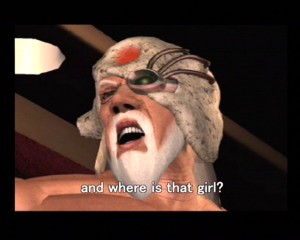 In terms of looks and sound, this is your typical SEGA arcade game. Colourful, large sprites are animated in an exaggerated caricature style to make the action all seem extreme and in-your-face. The sprites are very blocky and the whole game features a very low level of detail overall, but for the simplistic gameplay this doesn’t pose a problem. The pre-rendered cutscenes are truly horrible and the human character models look awful. In the arcade these cutscenes were all put together in the in-game engine and although that isn’t exactly graphically impressive, at least it doesn’t clash so much with the regular gameplay sections. It just wasn’t worth the effort to add in such badly made CGI videos.
In terms of looks and sound, this is your typical SEGA arcade game. Colourful, large sprites are animated in an exaggerated caricature style to make the action all seem extreme and in-your-face. The sprites are very blocky and the whole game features a very low level of detail overall, but for the simplistic gameplay this doesn’t pose a problem. The pre-rendered cutscenes are truly horrible and the human character models look awful. In the arcade these cutscenes were all put together in the in-game engine and although that isn’t exactly graphically impressive, at least it doesn’t clash so much with the regular gameplay sections. It just wasn’t worth the effort to add in such badly made CGI videos.
The sound is also suitably over-the-top. The voice acting is all either completely camp or extreme, with strange yells and grunts making up all of the in-action sounds and badly scripted dialogue which is delivered horribly throughout the CGI scenes. This is all layered over some really cheesy music, that is almost a staple of all SEGA arcade titles. The music is almost always too high-tempo and jolly for the action that is going on but that is part of the charm of these SEGA titles; they were intentionally silly and the cheesiness is what gives the game their character.
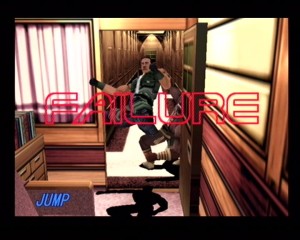 Without the crazy weapons, unusual bosses and enemies, and the quite horrible soundtrack the game wouldn’t be half as much fun. At the time, if you had spent forty pounds on the game you probably would have felt very hard done by. This is clearly an arcade title and had no real changes made for the home console release that justify its conversion, but it really is great if you just want to blast through a few stages and destroy loads of bad guys, accompanied by a second player. You won’t need your brain for this one and it certainly won’t keep you occupied for long, but you will laugh, and enjoy some real retro action at the same time. The game will never go down as a classic, and in some ways is seen as a failure after the success of the first, Die Hard licensed game in the series. The lack of a license allowed the developers to go all out and let their imaginations run wild for the sequel.
Without the crazy weapons, unusual bosses and enemies, and the quite horrible soundtrack the game wouldn’t be half as much fun. At the time, if you had spent forty pounds on the game you probably would have felt very hard done by. This is clearly an arcade title and had no real changes made for the home console release that justify its conversion, but it really is great if you just want to blast through a few stages and destroy loads of bad guys, accompanied by a second player. You won’t need your brain for this one and it certainly won’t keep you occupied for long, but you will laugh, and enjoy some real retro action at the same time. The game will never go down as a classic, and in some ways is seen as a failure after the success of the first, Die Hard licensed game in the series. The lack of a license allowed the developers to go all out and let their imaginations run wild for the sequel.
Perhaps a little too wild at times.
The God is a Geek Retro Corner will return on the first Friday of next month. You can see previous entries into the GodisaGeek Retro Corner by clicking here.




